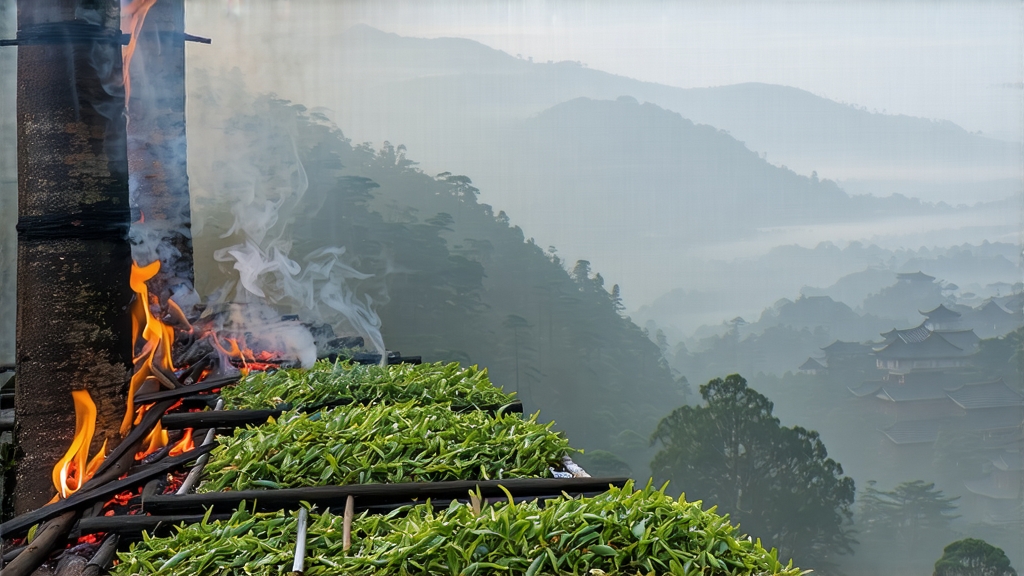
If every tea tells a story, Lapsang Souchong whispers legends of war, trade galleons, and mist-locked cliffs above the Min River. Hailing from Tongmu Village, a protected enclave deep within the Wuyi Mountains of Fujian Province, this is the black tea that startled 17th-century London dockworkers, seduced Russian tsars, and—according to Qing-era archives—became the first intentionally oxidised leaf in Chinese history. Today, when sommeliers speak of “smoke” in wine or whisky, they unknowingly echo the sensory code first written by Lapsang Souchong.
History: From Ming Frontier Tea to Earl Grey’s Muse
Tongmu’s settlers began smoking tea not for fashion but survival. Late-Ming militia, stationed nearby to repel coastal raiders, commandeered drying sheds for horse fodder, forcing farmers to finish their spring harvest overnight over open pine fires. The accidental flavour proved marketable; by 1604 Dutch traders had rebranded it “bohea” (from “Wuyi”) and shipped it to Amsterdam alongside porcelain and silk. In 1662 Catherine of Braganza’s dowry chest contained two pounds of “Souchon,” cementing the tea’s status in British court culture. Later, Charles Grey’s London blenders added bergamot oil to a base of lower-grade Lapsang, creating the world’s first scented black tea in homage to its smoky backbone.
Micro-Terroir: Why Only Tongmu Can Birth Authenticity
The Wuyi core protection zone—87 square kilometres of subtropical forest where the provinces of Fujian and Jiangxi meet—enjoys a unique diurnal fog. Daytime temperatures at 600–1,200 m coax slow photosynthesis; night-time mists lock in aromatics. The soil is a friable, mineral-rich tuff derived from weathered volcanic breccia, drainage so sharp that roots plunge three metres in search of water, concentrating polyphenols. Only six indigenous cultivars are permitted for authentic Lapsang: Xiao Ye Zhong (Small Leaf), Ai Jiao Zhong (Dwarf Foot), and four clonal selections registered as Wuyi numbers 1–4. Leaves picked outside this micro-zone may be labelled “Zheng Shan” (original mountain) style, but connoisseurs know the difference in the first sniff.
Leaf Architecture: The Two Faces of Souchong
Lapsang is harvested in three distinct flushes, each yielding a stylistic variant. Spring buds (March 20–April 10) produce “Jin Jun Mei,” a downy, honeyed offshoot that commands over US $1,000 per 100 g. The traditional picking standard for classic Lapsang is one bud plus the first three leaves, plucked when the third leaf is still half-open, ensuring a balance of catechins and amino acids. Summer leaves (May 20–June 20) carry more tannin and are reserved for export-grade smoking. An autumnal third flush, rarely seen outside Fujian, yields a lighter, stone-fruit cup favoured by local monks for its lower caffeine.
Craft: The Eight Stages of Smoke and Fire
Withering begins within 30 minutes of plucking. Leaves are spread 3 cm deep on bamboo trays suspended above pine-fired troughs; ambient temperature is held at 28 °C for 4–5 hours while artisans rock the trays every 20 minutes to bruise the edges, jump-starting oxidation. Once the grassiness subsides and a faint apple-peel note emerges, the leaf is rolled under 8 kg pressure for 45 minutes, breaking cell walls and releasing juice that will later polymerise into theaflavins.
Oxidation follows in cedar-lined boxes kept at 24 °C and 85 % humidity. Here the leaf transforms from emerald to copper; technicians sniff the pile every 15 minutes, waiting for a transition from floral to dried-longan aroma. The critical decision comes at 80 % oxidation—any longer and the smoke will taste acrid.
Firing is the signature step. Instead of the electric ovens used for Keemun or Dian Hong, Tongmu craftsmen build a pinewood bonfire in a sunken hearth, cover it with a bamboo mat, and spread the oxidised leaf 5 cm above the smouldering resin. The smoke must be cool (35–40 °C) and fragrant;